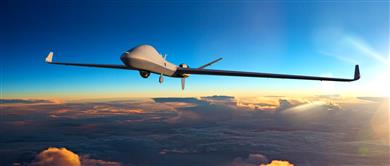
General Atomics Aeronautical Systems, Inc (GA-ASI) marks an important technology milestone as its first metal additively manufactured part takes to the skies on a SkyGuardian Remotely Piloted Aircraft (RPA) test flight.
GE Additive AddWorks™ has been supporting GA-ASI’s strategy for scaling metal additive technology across its portfolio of RPA platforms.
From Design to Test Flight in Six Months
Over the past nine years, GA-ASI has built deep experience with polymer-based additive technologies and over recent years, has made strides in developing its metal additive roadmap and a dedicated additive manufacturing team.
After establishing the required ecosystem requirements to develop its metal additive manufacturing application space, the GA-ASI Additive Manufacturing (AM) team identified a series of parts and families of applications with potentially favorable business cases.
Last year, the GA-ASI AM core team selected GE Additive AddWorks to support the acceleration of metal laser powder bed fusion (LPBF) additive development at the company, with the objective of having its first 3D-printed metal part take flight within an aggressive timeline.
GA-ASI and GE Additive AddWorks began collaborating in April 2019, an engagement that included a wide range of engineering consultancy services, such as design for additive (DfAM) training, industrialization process development and materials validation for Titanium and other metals - to optimize part design and accelerate part qualification.
Within eight months, this intensive period of collaboration resulted in the GA-ASI additive manufacturing team reaching the milestone they had set themselves – performing the company’s first test flight of a metal 3D-printed part - a NACA inlet made in Titanium Ti6Al4V – on a SkyGuardian RPA in early February 2020.
Defining the business case and part selection
With a desire to secure an early win, the GA-ASI AM team had already begun to identify a pipeline of suitable components for metal additive manufacturing and had started to tie them back to GA-ASI’s business priorities.
During that process, a NACA inlet[1] was identified as a strong contender to be the first metal 3D-printed part for the SkyGuardian program.
After assessing the business case, part criticality as well as program impacts, GA-ASI selected the NACA inlet as their first metal component to be qualified, the GE Additive AddWorks team was able to accelerate and support the industrialization process and production readiness of the NACA inlet by unlocking design potential, as well as providing expertise to reduce deterministically the qualification risks.
“We know firsthand that the ability to secure buy-in from multiple cross-functional stakeholders is often critical to the success of any metal additive program within an organization. By adding GE’s prior experience and perspective to the GA-ASI’s internal leadership efforts, the joint team was able to reach the required project momentum in order to meet their milestone,” said Lauren Thompson, operations project manager at GE Additive AddWorks and part of the team working with GA-ASI.
“Combining our deep domain expertise of metal additive and best practices from our own additive journey with GA-ASI’s equally deep domain expertise of their RPA applications allowed us to move quickly and work within the timelines we had set,” added Thompson.
Weight, cost and part reduction
Following the successful test flight, the NACA inlet will now enter the final qualification phase for the SkyGuardian program.
The reimagined single piece NACA inlet in Titanium Ti6Al4V offers GA-ASI significant reductions to its weight and cost, especially when compared to the conventional method of manufacturing that makes the inlet from three parts of welded formed sheet metal Titanium. This made tooling, fabrication labor and weld inspection a challenge.
The inlet is now additively manufactured as a single piece, rather than three - on a Concept Laser M2 machine - and delivers a cost reduction per part of more than 90%, weight reduction of over 30%, and tooling reduction of approximately 85%.
Consolidating the number of parts has numerous benefits, including reduced procurement cost. Reduced assembly and inspection time in turn simplifies GA-ASI’s supply chain and inventory requirements.
Following the successful completion of the work on the first inlet, the GA-ASI team is already applying best practices and knowledge to its wider NACA inlet part family and several other components and sub-systems.
The Path to Volume Production
And as a result of its achievements and progress through 2019, GA-ASI’s has placed an order for multiple GE Additive Concept Laser M2 Series 5 machines, which will be installed at its new Additive Design & Manufacturing Center of Excellence in Poway, California in 2020; adding to their already existing non-metal AM capabilities. The strategy to achieve production was to establish the necessary ecosystem of knowledge and tools to achieve industrialization level. Adding internal printing capabilities will serve both GA-ASI’s application space development, as well as allow rapid reaction manufacturing.
The GE Additive AddWorks team have become trusted advisors to GA-ASI and will likely continue to provide consultancy and expert advice as it moves to further scale metal additive across its business by enabling additional metal additive components for various programs.
“With the GE Additive AddWorks team, we were able not only to achieve our short term objective of qualifying the NACA inlet, but we also worked together on a number of additional application development and qualification efforts, which are continuing into 2020 and beyond,” said Elie Yehezkel, senior vice president of Advanced Manufacturing Technologies for GA-ASI.
“It is important that we remain at the leading edge of manufacturing technologies for our products and our customers. This acceleration has driven the maturation of our metal AM strategy and has also informed how we plan to approach a much wider application space already in the pipeline,” added Yehezkel.
www.ge.com


















































































